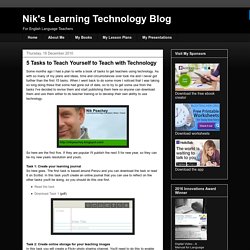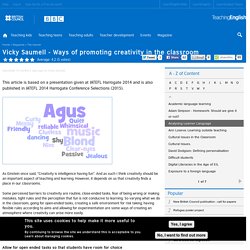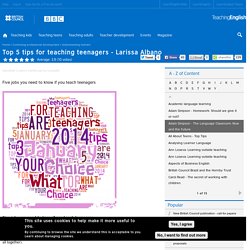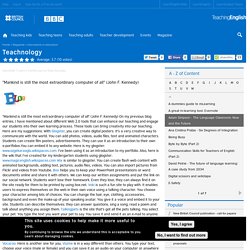

Using web resources to create tasks with real outcomes. Over the last years I’ve gradually developed a working method that seems, at least, to tackle the problem.

It’s based on using web publishing resources for creating tasks which are relevant to students and that produce tangible results. Case studyThe broader context – task-based learning and developing PLEsDrawing out the implications Case study: presenting a recipe taskIn my first session with a group of adult students (Basque School teachers) we set up a class blog and, soon after, identified that pronunciation was an area they wanted to focus on. 10 Tasks for Training Teachers to Use Web 2.0 Tools. Nik's Learning Technology Blog: 5 Tasks to Teach Yourself to Teach with Technology. Some months ago I had a plan to write a book of tasks to get teachers using technology.

As with so many of my plans and ideas, time and circumstances over took me and I never got further than the first 15 tasks. Creating Word clouds. Vicky Saumell - Ways of promoting creativity in the classroom. As Einstein once said, “Creativity is intelligence having fun”.

And as such I think creativity should be an important aspect of teaching and learning. However, it depends on us that creativity finds a place in our classrooms. Some perceived barriers to creativity are routine, close-ended tasks, fear of being wrong or making mistakes, tight rules and the perception that fun is not conducive to learning. So varying what we do in the classroom, going for open-ended tasks, creating a safe environment for risk taking, having flexible rules according to aims and allowing for experimentation are some ways of creating an atmosphere where creativity can arise more easily. Although my teaching background is mostly with teenagers, the ideas in this article can be used with all age groups. Allow for open ended tasks so that students have room for choice Choice is a natural partner of creativity.
10 Tasks for Training Teachers to Use Web 2.0 Tools. Gavin Dudeney: 21st Century Skills & Digital Literacy in Action. Many of the skills often described as 21st century skills do indeed have both analogue and digital applications, but developing 21st century skills alone does not make someone ‘digitally literate’.

Thus, 21st century skills can be developed and integrated into digital literacy-based activities, but the two are not synonymous with each other, exactly. In this article, then, we take a look at how 21st century skills can be incorporated into technology-mediated activities and classes. Before you read this article, please ensure you have read the Digital Literacies Primer for a basic introduction to digital literacy. One of the easiest ways of incorporating both digital literacy and 21st century skills development into standard lesson plans is to start where most teachers find themselves: with a unit of a course book or teaching materials. A typical example might look like this: Top 5 tips for teaching teenagers - Larissa Albano. Five jobs you need to know if you teach teenagers We all know we can’t judge a book by its cover.

Teenagers are not as bad as they are described. Personally, they have been teaching me a lot and they helped me improve my expertise in teaching and even in other fields. Larissa Albano: With or without technology. "Adapt yourself to the new technologies.

At home with the help of family or friends get used to smartphones, tablets and other tech tools so that you can use them in class with learning purposes. You don’t need to become tech-savvy but if you ban the prohibition “DON’T USE YOUR PHONE DURING THE CLASS”, your students will be delighted to learn by using their phones”. I once enthusiastically wrote this in one of my guest blog posts in order to give suggestions to teachers about keeping motivated themselves and their students. Teachnology. "Mankind is still the most extraordinary computer of all" (John F.

Kennedy) On my previous blog entries, I have mentioned about different Web 2.0 tools that can enhance our teaching and engage our students into their own learning process. These tools can bring creativity into our teaching. Here are my suggestions: With Glogster, you can create digital posters. It's a very creative way to communicate with the world. You can add photos, videos, audio files, text and animated characters. 5 Tasks to Teach Yourself to Teach with Technology. Learning Technologies: being sceptical and conservative. When bringing some new learning technologies into class, there is always a possibility - or even a danger - of using learning technologies just for the sake of using them, because we are seduced by bright screens, cool apps, interactivity, sounds and speed, so it always pays to ask yourself if a technology you were charmed by is really going to contribute some valuable angle to your not too hi-tech class before.

Well, at least that's true in my situation, in the context of corporate teaching. I am almost sure I am missing something big, but as for now, I have much fewer opportunities for putting to use smart learning technologies in a really effective way, than, say, school teachers - with all the overhead projectors and smart whiteboards. Chris Baldwin: Learning Technologies for the classroom_0.